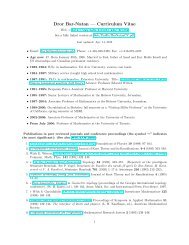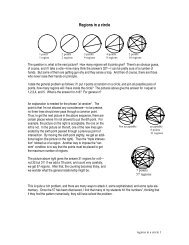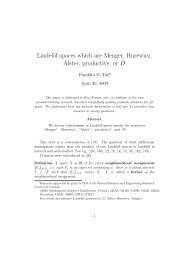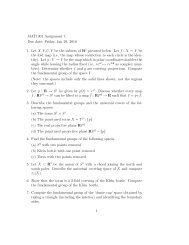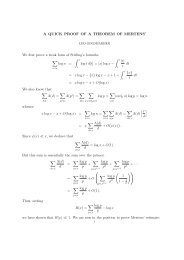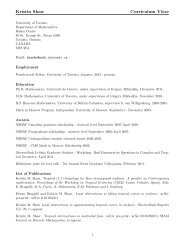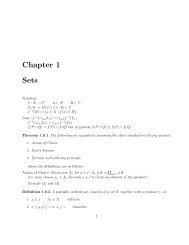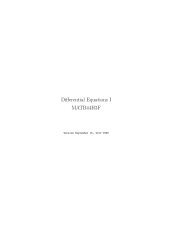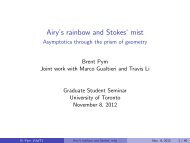MAT 445/1196 - INTRODUCTION TO REPRESENTATION THEORY ...
MAT 445/1196 - INTRODUCTION TO REPRESENTATION THEORY ...
MAT 445/1196 - INTRODUCTION TO REPRESENTATION THEORY ...
You also want an ePaper? Increase the reach of your titles
YUMPU automatically turns print PDFs into web optimized ePapers that Google loves.
(3) Determine whether the self-representation of GLn(R) (restrict the self-representation<br />
of GLn(C) to the subgroup GLn(R)) is equivalent to its dual.<br />
(4) Prove that a finite-dimensional representation of a finite abelian group is the direct<br />
sum of one-dimensional representations.<br />
1.2. Tensor products<br />
Let (πj, Vj) be a representation of a group Gj, j = 1, 2. Recall that V1 ⊗V2 is spanned<br />
by elementary tensors, elements of the form v1 ⊗ v2, v1 ∈ V1, v2 ∈ V2. We can define a<br />
representation π1 ⊗ π2 of the direct product G1 × G2 by setting<br />
(π1 ⊗ π2)(g1, g2)(v1 ⊗ v2) = π1(g1)v1 ⊗ π2(g2)v2, gj ∈ Gj, vj ∈ Vj, j = 1, 2,<br />
and extending by linearity to all of V1 ⊗ V2. The representation π1 ⊗ π2 of G1 × G2 is<br />
called the (external or outer) tensor product of π1 and π2. Of course, when π1 and π2 are<br />
finite-dimensional, the degree of π1 ⊗ π2 is equal to the product of the degrees of π1 and<br />
π2.<br />
Lemma. Let (πj, Vj) and Gj, j = 1, 2 be as above. Assume that each πj is finitedimensional.<br />
Then π1 ⊗ π2 is an irreducible representation of G1 × G2 if and only if π1<br />
and π2 are both irreducible.<br />
Proof. If π1 or π2 is reducible, it is easy to see that π1 ⊗ π2 is also reducible.<br />
Assume that π1 is irreducible. Let n = dim V2. Let<br />
Hom G1(π1, π1) n = Hom G1(π1, π1) ⊕ · · · ⊕ Hom G1(π1, π1),<br />
and πn 1 = π1 ⊕ · · · ⊕ π1, where each direct sum has n summands. Then Hom G1 (π1, π1) n <br />
Hom G1 (π1, πn 1 ), where the isomorphism is given by A1⊕· · ·⊕An ↦→ B, with B(v) = A1(v)⊕<br />
· · · ⊕ An(v). By (the corollary to) Schur’s Lemma, Hom G1(π1, π1) C. Irreducibility of<br />
π1 guarantees that given any nonzero v ∈ V1, V1 = Span{ π1(g1)v | g1 ∈ G1 }, and this<br />
implies surjectivity.<br />
Because V2 Cn and C Hom G1(π1, π1), we have<br />
(i) V2 Hom G1 (π1, π1 ⊗ 1 n ),<br />
where π1 ⊗ 1 n is the representation of G1 on V1 ⊗ V2 defined by (π1 ⊗ 1 n )(g1)(v1 ⊗ v2) =<br />
π1(g1)v1 ⊗ v2, v1 ∈ V1, v2 ∈ V2. (Note that this representation can be identified with the<br />
restriction of π1 ⊗ π2 to the subgroup G1 × {1} of G1 × G2).<br />
If m is a positive integer, then<br />
(ii)<br />
V1 ⊗ Hom G1 (π1, π m 1 ) → V m<br />
1<br />
v ⊗ A ↦→ A(v)<br />
7



